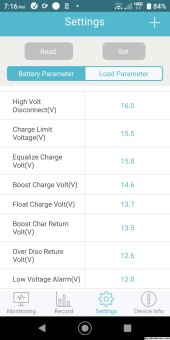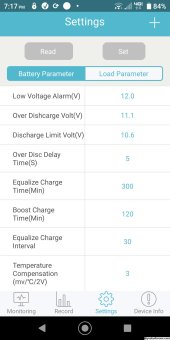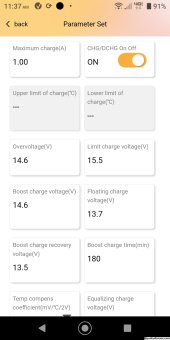Yay! With everyone's help I was able to get my system upgrade done and up and running. I definitely dont understand everything but was able to put everything together successfully and have majorly improved my incoming electricity!
I am using an existing Lifeline 210 AH AGM model # GPL-4DL (battery likely 3-4 years old) with Renogy 40A Rover MPPT powered by 600W on Renogy 100w panels.
I don't have the manual from the battery since the PO of my RV did not save it. I have been able to find most battery settings on Lifeline's site but a few I'm unsure about. Attached is screen shots of the custom 'user' settings I have done on the Renogy controller.
One thing I really want to confirm is the equalization settings. I heard not to use them for AGM batteries but then I read I should do equalization here on Lifeline page. https://lifelinebatteries.com/blog/can-i-equalize-agm-batteries/ Can someone explain this more and I also don't understand if I manually start an equalization or does it happen automatically?
Other specific settings I have no guidance from Lifeline on are.
1) High Volt Disconnect
2) Charge Limit Voltage
3) Over Disc. Return Volt
4) Low Voltage Alarm
5) Over Discharge Voltage
6) Discharge Limit Voltage
7) Over Discharge Delay Time
8) Equalize Charge Time Interval
9) Temperate Compensation

I am using an existing Lifeline 210 AH AGM model # GPL-4DL (battery likely 3-4 years old) with Renogy 40A Rover MPPT powered by 600W on Renogy 100w panels.
I don't have the manual from the battery since the PO of my RV did not save it. I have been able to find most battery settings on Lifeline's site but a few I'm unsure about. Attached is screen shots of the custom 'user' settings I have done on the Renogy controller.
One thing I really want to confirm is the equalization settings. I heard not to use them for AGM batteries but then I read I should do equalization here on Lifeline page. https://lifelinebatteries.com/blog/can-i-equalize-agm-batteries/ Can someone explain this more and I also don't understand if I manually start an equalization or does it happen automatically?
Other specific settings I have no guidance from Lifeline on are.
1) High Volt Disconnect
2) Charge Limit Voltage
3) Over Disc. Return Volt
4) Low Voltage Alarm
5) Over Discharge Voltage
6) Discharge Limit Voltage
7) Over Discharge Delay Time
8) Equalize Charge Time Interval
9) Temperate Compensation







